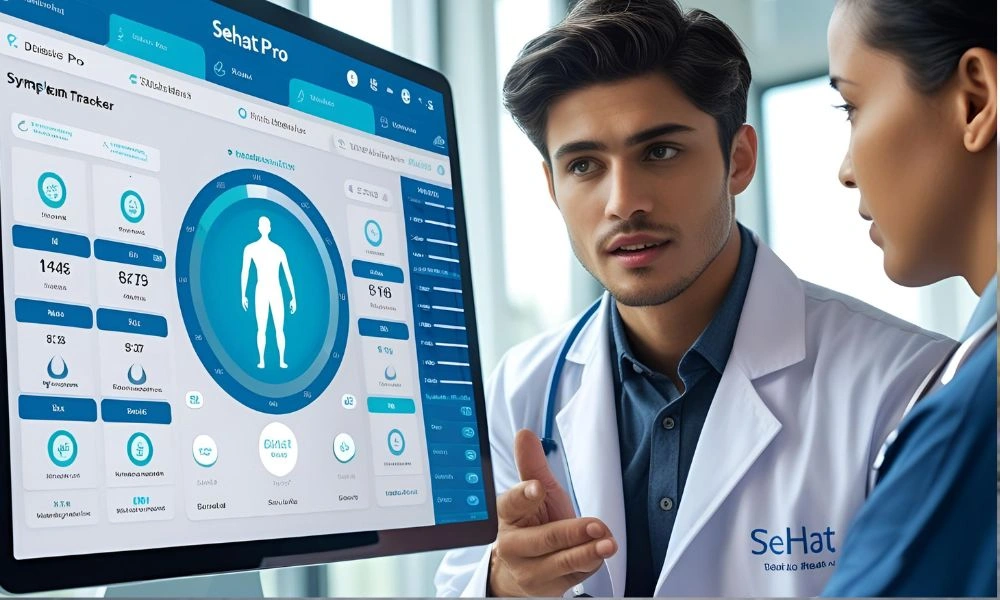
What is Gastroparesis and How is It Related to Diabetes?
Did you ever ask yourself why some patients with diabetes tend to experience bloating, vomiting, or feeling full too early? These painful symptoms may indicate gastroparesis, a less common but serious condition that tends to lie in the background of diabetes.
Gastroparesis is literally “stomach paralysis.” In other words, it’s when the muscles of the stomach become slower or even fail to function normally, resulting in delayed digestion. In diabetic patients, it’s a two-edged sword: their blood sugar is difficult to control, and now their stomach is no longer functioning correctly.
This is more than mere discomfort. It’s a chronic illness that quietly impacts quality of life and health outcomes for millions of patients. And this is where Sehat Pro makes all the difference for physicians and small clinics.
How Does Diabetes Cause Gastroparesis?
Diabetes is a chronic metabolic disorder that injures blood vessels and nerves all over the body. The vagus nerve is one of the most important nerves that controls stomach motility. When diabetes damages the nerve chronically, the muscle of the stomach cannot contract normally.
The consequence? Food lingers in the stomach for longer than it should. This slows down nutrient absorption and disrupts blood sugar levels — causing even more problems.
Physicians require a better solution to monitor these intersecting symptoms and offer timely patient insights. Sehat Pro, specifically created for clinics and healthcare professionals, is able to detect trends, save medical histories, and provide smarter treatment options.
Who is Most Likely to Develop Diabetic Gastroparesis?
Individuals with Type 1 and Type 2 diabetes with long-term poor glycemic control are more likely. Females appear to be more susceptible than males. Other risks are:
- History of long-standing diabetes
- Obesity
- History of prior surgeries or trauma to the stomach
- Use of specific medications such as narcotics or antidepressants
As a clinique, early identification of high-risk patients can be the game-changer. With Sehat Pro, red flags are monitored through alerts and data analysis — allowing clinics to intervene before matters get out of hand.
What are the Symptoms Physicians Need to Look Out For?
Gastroparesis does not appear overnight. Its symptoms mimic ordinary digestive problems. However, for diabetic patients, they become long-term and life-threatening:
- Nausea and vomiting
- Feeling bloated even after eating small amounts of food
- Abdominal bloating
- Acid reflux or heartburn
- Weight loss unexpectedly
- Unpredictable levels of blood sugar
Sehat Pro enables clinicians to monitor chronic complaints, see the frequency of symptoms, and associate them with patient vitals — accelerating and improving diagnosis.
Why is Gastroparesis Hazardous to Diabetics?
Delayed gastric emptying results in longer gastric retention of food, releasing sugar erratically into the circulation. This makes insulin management extremely challenging. Patients can develop:
- Dangerous hypoglycemic episodes
- Severe hyperglycemia
- Vomiting and malnutrition due to poor absorption
- Dehydration or infections-induced hospitalizations
This creates undue burden on smaller clinics and hospitals that are already facing resource issues. Sehat Pro provides a comprehensive solution combining patient monitoring, medication reminders, and glucose trend tracking — preventing complications and saving lives.
How Clinics Can Effectively Diagnose Gastroparesis?
The diagnosis of the condition is made with a combination of clinical observation and diagnostic tests such as:
- Gastric emptying studies
- Upper endoscopy
- Smart pill motility testing
- Ultrasound
But these exams can’t be done every day. That’s where digital follow-up and symptom logging by the patient enter the scene.
With Sehat Pro, symptoms can be reported right into patients’ profiles. Physicians receive daily information without having to wait for the next visit. It’s real-time care without workload increase.
Treatment Options: Treatment of Gastroparesis in Diabetic Patients
There is no definitive cure, but treatment is aimed at controlling both blood glucose and symptoms. This may consist of:
- Small, frequent meals
- Low-fat and low-fiber diet
- Medications that stimulate stomach muscle activity
- Insulin adjustments
- Severe cases might necessitate feeding tubes
Coordination is needed to manage multiple treatment avenues. Sehat Pro’s multi-profile patient management system enables clinicians to tailor care plans, create medication reminders, and monitor adherence — all in a single dashboard.
Sehat Pro: Revolutionizing Gastroparesis Management in Clinics
Legacy EHR systems aren’t engineered for diseases such as diabetic gastroparesis — complex, long-term, and variable. But Sehat Pro is designed for contemporary clinics that desire more than just records. It provides:
- Smart dashboards to identify symptom patterns
- Personalized alerts when patient vitals exceed range
- Embedded glucose data visualization
- Treatment plan tracking among multiple experts
- Teleconsultation modules for remote patient care
The purpose? Improved patient care. Reduced emergency visits. Increased trust in your clinic.
Why Sehat Pro is a Game Changer for Small Hospitals and Doctors?
You don’t need a multi-million dollar hospital to offer world-class diabetic care. Sehat Pro turns your clinic into a precision health center. You’ll be able to:
- Track complicated conditions like gastroparesis with confidence
- Reduce documentation burden
- Focus more on care and less on paperwork
- Use data to make smarter decisions
- Increase patient retention with better outcomes
Imagine a completely integrated patient monitoring system that doesn’t need a tech team to operate it. That’s Sehat Pro. Easy, intelligent, and mighty.
What Separates Sehat Pro from Other Medical Software?
✅ Built for Pakistani healthcare operations
✅ Simple enough for non-technical staff members
✅ Competitively priced for clinics and solo practitioners
✅ Multilingual and highly customizable
✅ Integrated data security and patient privacy functionality
✅ Scalable — expand from clinic to hospital with ease
You’re not just buying software — you’re investing in your clinic’s future.
Final Thoughts: From Symptoms to Solutions
Gastroparesis and diabetes form a silent but deadly combination. For doctors and clinics, early detection and consistent tracking are critical. But without the right tools, that’s nearly impossible.
Sehat Pro bridges the gap. It empowers small setups with big capabilities — all while keeping things simple and cost-effective.
If you are a medical practitioner who is willing to move beyond forms and provide more intelligent diabetic care, then it’s time to take Sehat Pro to your clinic.
Frequently Asked Questions (FAQ)
Diabetes can damage the vagus nerve, which controls the movement of food through the stomach. When this nerve is impaired, digestion slows down significantly, leading to gastroparesis. This condition is more common in long-term diabetic patients with poor blood sugar control.
While traditional tests like gastric emptying studies are helpful, early diagnosis often comes from symptom tracking. Clinics can use Sehat Pro to monitor recurring symptoms such as nausea, bloating, and unstable glucose levels — catching warning signs before they become serious.
Treatment includes diet changes, medications, glucose management, and in severe cases, feeding assistance. Sehat Pro helps healthcare providers track these interventions over time, offering a structured way to monitor improvement or worsening of symptoms.
Because food leaves the stomach at unpredictable rates, it becomes hard to time insulin properly. This can lead to both hypoglycemia and hyperglycemia. Sehat Pro provides clinicians with data trends and alerts, helping them adjust insulin and meal plans more accurately.
Sehat Pro offers a comprehensive platform for tracking symptoms, managing treatment plans, and visualizing glucose trends. It reduces manual effort, improves diagnostic accuracy, and enhances patient communication — all while keeping your clinic operations smooth and efficient.
